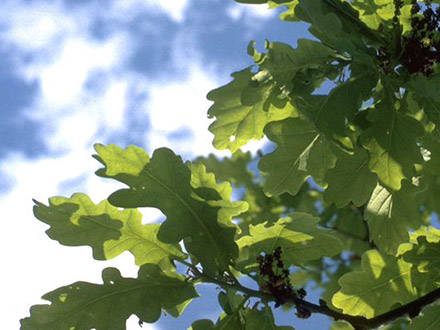Botanical name
Quercus robur L.
Quercus petraea (Matt.) Liebl.
Quercus pubescens Willd.
Family
Fagaceae
Common name
Common oak, English oak, Pedunculate oak
Sessile oak, Durmast oak, Irish oak
Downy oak, Pubescent oak
Information about the plant
The oak tree has been known to exist since the Cretaceous period. It is characterized by its longevity, living up to 2000 years, and can reach a height of 45m with a trunk diameter of several meters. They always impress people with their highly individual, even idiosyncratic form. In ancient cultures, they were consecrated as powerful deities. It was revered by many Indo-European people as a sacred tree; in Greece, it was Zeus, the Romans dedicated it to Jupiter, and the Germans to Thor. Celts, Teutons, and Slavs made their sacrifices in oak groves. Many oak trees were felled over the course of Christianization. Shrines with Mary were then associated with the oak tree. In the 18th century, they were also regarded as a symbol of strength and heroism in Germany.
The main distribution area of the genus Quercus is In North America, although some species grow in Europe and Western Asia. The common oak (or English oak), the sessile oak (or durmast oak), and the pubescent oak (or downy oak) are native to us. These three species resemble each other closely and hybridize readily. Oaks thrive in warm conditions and prefer low, damp areas. They are part of hardwood forests; on barren ground, the oak is easily displaced by the beech.
Oak is easy to identify with its typical sinuously lobed leaves and very thick bark. Its fruits, acorns, are nuts individually set in a scaly fruit cup, the cupula. The foliage of the trees is rather light. The English oak (Q. robur), most common in Europe, usually has a short trunk and a more spreading crown. It also grows as a solitary tree. Its English name refers to the long-stalked fruits, while the species epithet robur alludes to the darker color of the heartwood compared to the sapwood (from Latin "ruber" = red). It flowers earlier than the Sessile oak and is therefore called the "summer oak", while the durmast oak (Q. petraea) is called the "winter oak". It has a higher trunk and fruit, and likes to grow on dry stony ground, which is reflected in its name epithet petraea (Greek "petraios" = rock). The downy oak (Q. pubescens) grows mainly in southern Europe; in Germany it is only found in the warm southern slopes of the Rhine Graben. It is significantly smaller (20m), and its young twigs and leaves have delicate hairs, which is reflected in the species epithet pubescens (Latin "pubescens" = downy).
The oak is a valuable crop because it is processed into high-grade lumber. Previously, the bark was used for the tanning of hides due to its tannin content. The evergreen, western Mediterranean cork oak (Quercus suber) with its up to 10cm thick bark, is used to produce cork.
Medicinally used parts of plants (herbal drug)
The dried bark of fresh, young branches of the three oak species is used. The commercially available drug comes from various Eastern and Southern European countries.
Constituents of the herbal drug
Oak bark contains tannins in the form of ellagitannins (hydrolyzable tannins) and catechin tannins (condensed tannins) in a ratio of 77:23. It also contains complex tannins, including flavanoellagitannins.
Quality of the drug
The quality of oak bark (Quercus cortex) is specified in the European Pharmacopoeia (Ph. Eur.).
Medical applications
Recognised medical use
The HMPC has classified oak bark as a traditional herbal medicinal product (see ‘Traditional use’).
ESCOP: Oak bark has not been processed.
Traditional use
Oak bark has been classified by the HMPC as a traditional herbal medicinal product (Article 16a of Directive 2001/83/EC). Based upon long-standing use, oak bark can be used internally for the symptomatic treatment of mild diarrhea and externally for mild inflammation of the skin and mucous membranes. Oak bark is also used externally to relieve itching and burning in hemorrhoids.
Herbal drug preparations in finished dosage forms
- Chopped oak bark as a tea
- Alcoholic extracts in a bath
Dosage
Prepared drugs: see patient information leaflet.
Tea: For diarrhea, drink a cup of oak bark tea 3 times a day. 3g daily dose of the drug. For external use (flushing, compresses, gargle solution, baths), apply several times a day.
Preparation of a tea
For internal use: mix 1g of finely chopped or coarsely powdered drug with cold water, boil and strain after 5 min. For external use (flushing, compresses, gargle solution), prepare 20g of the drug with 1 liter of water; for full and partial baths, prepare 5g of the drug in 1 liter of water in the same way.
Notes
Medical advice must be sought in the event of prolonged and recurring diarrhea and bloody stools. Do not take hot baths in the case of febrile and infectious diseases, heart failure (cardiac insufficiency), and high blood pressure. Oak bark decoctions must not be used for weeping, extensive eczema and skin injuries.
No safety studies are available on the use of oak bark during pregnancy and lactation. It is also not recommended for use in children and adolescents under the age of 18 due to a lack of evidence.
Side effects
Allergic reactions at most.
Interactions
Not known for external use. When oak bark is taken internally, it may delay the absorption of concomitantly administered drugs; oak bark should, therefore, be taken at least 1 hour (before or after) the other medications.
References
Herbal drug monographs
HMPC (2011, 2020)
Further literature
Commentary on the European Pharmacopoeia (Oak bark, No. 1887)


